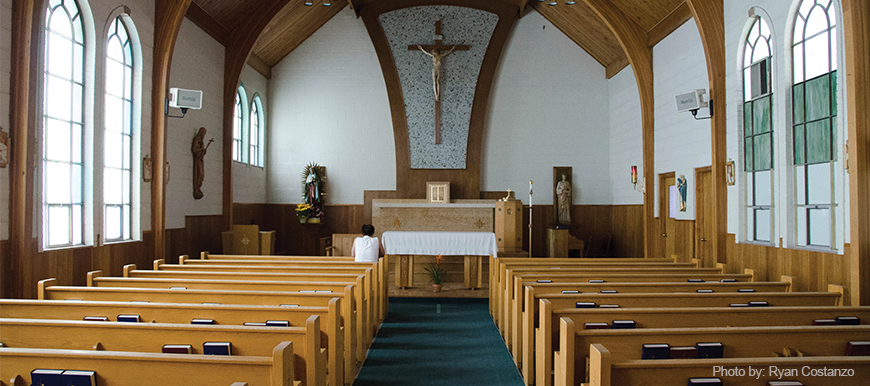4 USU students find peace in exploring their spirituality
Finding and determining one’s spiritual identity can be a heart-wrenching experience.
But for four Utah State University students — all involved with the Interfaith Student Association (IFSA) — their experiences led them to the answers and peace they were looking for.
“Allow yourself to question. Don’t feel like you have to be hemmed in by what others believe,” said Erica Hawvermale, a junior majoring in cultural anthropology with an emphasis in medical anthropology.
Hawvermale said she grew up agnostic in a home without any religious background and felt very anxious each time she would investigate other faiths. But all that changed last fall semester when she signed up for an Introduction to Shamanism class.
“I did all the readings for the class before we started class. All of them,” Hawvermale laughed. “I was fascinated. I couldn’t wait to take the class.”
She now identifies as a shamanic practitioner, saying she found more peace and answers during her introduction to shamanism class than anywhere else. She currently serves as the IFSA president.
“For me, shamanism was very much like coming home,” she said.
USU students aren’t alone in their search for spirituality. Religious questioning starts early in life for most people, according to Faith in Flux, a survey conducted by the Pew Research Center’s Forum on Religion and Public Life.
Many people who decided to leave their childhood faith did so before the age of 24, and a majority said they joined their current religion or non-religion before age 36, according to the survey.
As was the case with David Tauber, a senior in religious studies and anthropology.
Tauber, the vice president of the IFSA, said he was grew up agnostic and began to study religions when he was young.
He said he once visited the Logan Islamic Center and listened to a pilgrimage story about Muhammad. The speaker emphasized following personal beliefs and finding locations where religion is practiced however an individual sees fit. Tauber said the message resonated with him.
“That’s the goal,” he said. “For everybody to be comfortable being themselves and to be comfortable with everyone else being themselves, as well.”
Tauber said he identifies as a Western Buddhist, blending together western ideals and Buddhist traditions. He said everyone has unique situations to work through, and Interfaith is a safe and neutral ground for people to figure things out.
However, it’s difficult to find safe and neutral ground to openly discuss spirituality. That’s what inspired anthropology professor Bonnie Glass-Coffin to establish the Interfaith Initiative.
“There needed to be a safe haven, so that’s really what we tried to do in developing the Interfaith Initiative,” Glass-Coffin said. “To develop that safe haven for people to be able to come together and be able to voice all of who they are, to engage respectfully with people who are not like they are and learn how to bridge those differences in order to serve the common good.”
Bridging differences was crucial for Sarah Hammon, a junior majoring in global marketing, who identifies as a member of the Church of Jesus Christ of Latter-day Saints.
She said she grew up in staunch Roman Catholic family and attended Catholic school. But in her high school junior year Hammon said she was going through a rough time.
“I changed from being someone who loved their religion and loved everything it was about to being so mad with God all the time,” Hammon said.
After receiving a book of scripture and support from close friends, Hammon investigated the LDS church and joined soon after.
“I remember feeling like the biggest sense of peace I’d had in so many years,” she said, describing her feelings during the change. “It was so liberating, and it felt so good.”
Kason Hudman, a senior majoring in history, found that peace identifying as an Episcopalian. Raised with a very spiritual mother and an LDS father, Hudman said he wanted to figure out what he really believed.
As he was investigating other faiths, Hudman listed his family and his girlfriend as huge supporters to his search.
“If you feel like you don’t know if you identify with something, I think you should listen to yourself,” he said.
Hudman said he decided on the Episcopal church because it was open to all beliefs.
“We all kind of have similar motives for believing what we believe,” he said. “And that’s always really good because you realize the chasms between us are really not that deep.”
Glass-Coffin is providing free training on how to bridge chasms with those who have other world views. The trainings, “Better Together: Interfaith Ally,” will be held Sept. 22, 25 and 26. Glass-Coffin encourages anyone interested to contact her at bonnie.glasscoffin@usu.edu. The trainings are free of charge.
“The more experience people have with people of other religious traditions, the more they become aware that we live in a diverse world, even here in Utah,” Glass-Coffin said. “There’s diversity even here, and it’s very important not to make assumptions.”
—ashley.ruth.stilson@aggiemail.usu.edu

